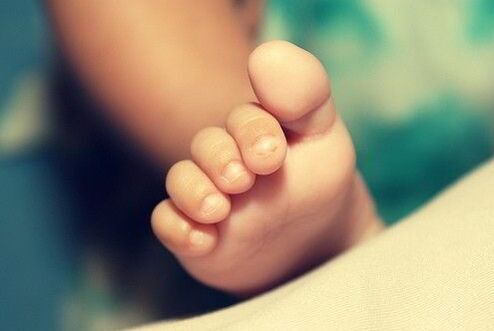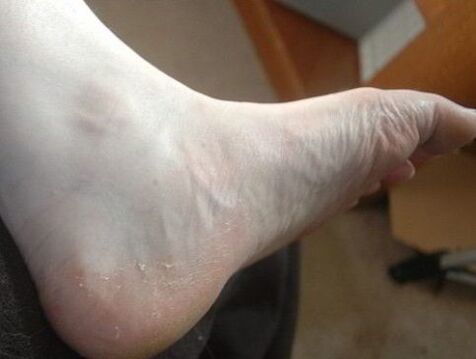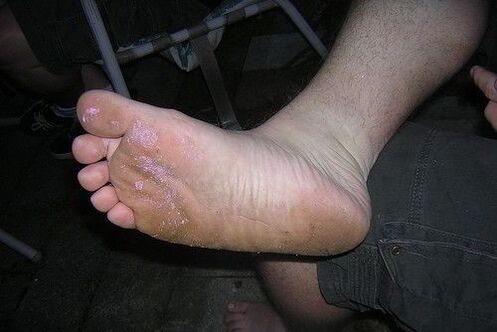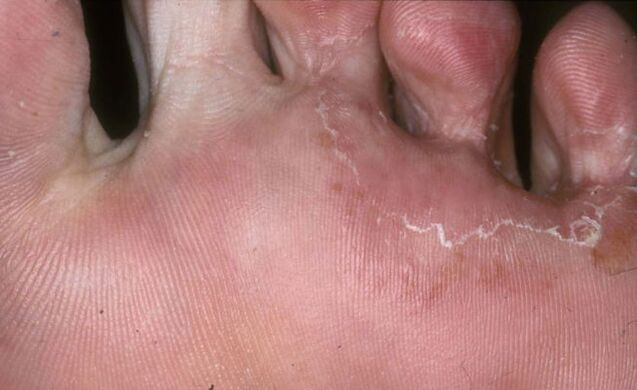Various types of fungi on human feet are called mycoses. When the skin is affected, the disease is referred to the group of dermatomycosis (epidermophytosis, trichophytosis), because the dermis is translated from the Greek as skin. If the nail is affected, then the disease is defined as onychomycosis.

The cause of the disease
Fungus on the feet is a common disease that occurs all over the world. More common in the city than in the countryside. Risk groups for foot fungus include athletes, bath workers, and hot shop workers. Children have thinner skin that is not protected from external factors, so they are also susceptible to mycoses. Another reason is an increase in foot sweating, as a result of diseases in the body or congenital features. Dermatologists believe that the risk of foot fungus infections increases with age. Factors that contribute to this disease:
- wearing uncomfortable small leather shoes;
- warm environment with high humidity, especially when wearing shoes;
- violation of blood supply to the extremities;
- frequent visits to crowded places;
- weakened or dysfunctional immune system;
- wearing unfamiliar shoes.
Fast infection
Foot dermatomycosis is easily spread in public places from sick people to healthy people. Infection occurs through contact surfaces: floors, household items, personal hygiene items, other people’s shoes. The fungus is spread through direct contact, it multiplies quickly, which is why it is very easy for them to get infected. The situation of fungal transmission in the hairdresser's salon through tools during pedicure, as well as towels, is not excluded. The disease attacks the skin of the feet. This is common in men, as they spend most of their time with closed -toe shoes. Frequent visits to the gym, bathing, military service, where you do not necessarily wear your own shoes - all this creates favorable conditions for the reproduction of pathogenic bacteria. Unventilated room areas are beneficial for disease -causing fungi for reproduction. The spread of pathogenic flora is very fast. The places where the fungus is dominant are the toes and the interdigital space. Saunas and baths are characterized by high humidity and temperature, which are ideal for the development of pathogenic microflora.
Fungal infections can be direct and indirect. Directly, you can be infected through direct contact with a sick person. Indirect pollution involves the use of objects that have been used by sick people.
Manifestations of mycoses
The first symptom of this disease is the appearance of skin scales on the feet. Through these elements, infection occurs. Increased sweating is a good factor for microbial reproduction, because the composition of sweat is transformed into nutrients for the growth of pathogenic flora.

Dirt residue and thread from the socks also accumulated between the toes. When a fungal infection is added to the listed factors, redness occurs there. The affected area begins to itch without pain, causing discomfort to the person. The skin begins to peel, which causes painful cracks to appear. While walking, there is an unpleasant painful sensation due to the presence of wounds on the skin of the feet. The skin begins to thicken, and the infection can spread to the nails. If left untreated, mycosis spreads and attacks the nail, destroying it. The nail plate first changes its color to white. After that, it can peel off. A void is formed between the nail plate and the nail bed. With fungus on the feet, an unpleasant odor appears. In winter, when closed shoes are worn, the feet are not ventilated, the intensity of foot lesions increases. For the treatment of this pathology, it is necessary to formulate an accurate diagnosis, as there are many types of fungal pathogens.
The main type of disease
- The membrane type (shape between origins) is the most common. Fungal infections were observed between the fifth and fourth toes. Gradually, the skin acquires a scaly structure with an element of cracking. Sometimes a bacterial infection attaches to the fungus, which causes damage to the skin of the feet.
- Types of moccasins. Manifested by pain in the legs. Then the skin thickens, thickens and cracks. Severe fungal lesions catch the nail, which over time can begin to crumble, peeling off.
- Vesicular type (dyshidrotic form). It is indicated by the appearance of blisters under the skin, filled with fluid. Often occurs in conjunction with a bacterial infection.
Type of fungus on the foot of the picture by name

There are many different types of fungi, they are suitable for various diseases. There are four most common types of fungi that cause damage to the feet.
- Trichophyton rubrum (Trichophytonrubrum) is fraught with rubrophytosis.
- Trichophyton interdigitale (Trichophytoninterdigitale) affects the skin between the fingers, which involves the entire foot in this disease. Causes epidermophytosis.
- Trichophyton mentagrophytes lead to complete epidermophytosis.
- Candida albicans is a female fungus. Causes candidiasis of the feet, but this is rare.

Epidermophytosis and trichophytosis (rubromycosis) are skin diseases collectively called foot mycoses, which are caused by parasitic fungi of the genus dermatophytes.
Welding
Dermatophyte fungi:
- microsporum;
- epidermophyton;
- t.
Molds that cause fungal diseases:
- hendersonula;
- altemaria;
- s.
Yeast pathogenic fungi:
- pityrosporum;
- candida;
- cryptococcus;
- malassezia;
- coccidoides;
- histoplasma;
- w.
Preventive measures

Since fungi love moist, humid habitats, this means having to violate these conditions to get rid of them. Therefore, to prevent fungus, the feet must be clean and dry. It is important to change your socks and dry your shoes on time. There are special antiperspirants that will inhibit the development of pathogenic microflora. It is better to choose leather shoes to maintain normal metabolic processes between the feet and the environment. The feet will sweat less, and breeding conditions will not be created for the fungus. It is best to wear socks at home, which you remove and wash, while microbes and dirt will accumulate in the shoes of the house.
You only have to use your own stuff, because you don’t know about the presence of other people’s diseases. Your immunity may not be able to cope with the pathogen and become infected. You need to show off your shoes regularly. When visiting public places, it is recommended to bring personal hygiene items with you. Do not walk barefoot on the floor in the pool and shower. The use of prophylactic antifungal creams and ointments also helps. After all, swimming pools, dressing rooms, saunas and other rooms with high humidity are breeding grounds for fungi. At home in the bathroom, it is better to push the porous carpet.
Risk groups
Some people are more susceptible to this disease than others. This may be due to problems in the body, such as:
- overweight;
- violation of blood circulation in the legs;
- flat feet and foot deformities;
- compromised immune system;
- people under stress;
- after antibiotic treatment.
Diagnostics of foot fungal diseases
The doctor performed a detailed foot examination, asking for a complaint. Skin samples are taken from patients for fungal testing. Fragments of skin are obtained by scratches on the bottom of a specially made. For analysis, nails were cut from the fungus -infected site. The presence of mycosis is determined by special tests. To identify the type of fungus, it is cultivated, i. e. it is cultivated. In rare cases, with advanced stages of the disease, the patient may be given a biopsy. In this case, the finished material is examined under a microscope.
Methods of treatment
To obtain results from treatment, it is necessary to clarify the type of fungus and the presence of infection, if any, has joined it. The degree of damage is also taken into account.
The basis of a membrane type treatment looks like applying antifungal medication to the affected area. Easy to do even at home. These drugs stop the growth of bacteria or slow the spread of disease. A large number of these medications are available over the counter without a prescription. The action of the substance occurs locally, at the site of application to the affected skin. It is important to monitor the dynamics of treatment, if there is no improvement, the drug may not help you.

If there is no effect from the agent used, then it is necessary to consult a dermatologist again about the appointment of other treatments. You may need to give stronger medication. In very severe cases during the disease, tablets are prescribed. Many drugs have side effects, so it is necessary to monitor blood volume during treatment with pills. The fungus is very difficult to cure completely, as it can recur. Treatment should not be interrupted, otherwise the fungi may show resistance to the components of the drug that affect them. During treatment, it is necessary to monitor the hygiene and dryness of the feet. With this form of moccasin infection, onychomycosis, i. e. damage to the nail, is very common. As the skin on the feet thickens and it is more difficult for the drug to penetrate into, the disease is more difficult to cure. In this case, standard medication "doesn’t work" and additional therapy in pill form is prescribed. Onychomycosis - damage to toenails by fungi of the genus dermatophytes. The disease can also be caused by yeast and fungi. There are several types of onychomycosis:
- Subungual distal. Depending on the area of the nail plate lesion, three degrees of damage are distinguished. If the nail is laid out in sections and conditionally divided into three parts (in depth), then a lesion of up to two -thirds in volume will correspond to the first two stages of the disease. And when more than 2/3 of the nails are affected by the fungus, this is already the third stage. In this case, the root of the nail (matrix) is involved in the process of the disease, and sometimes also the folds of skin on the sides of the nail, called the periungual ridge;
- proximal subungual. Defeat the back of the nail plate, where the hole is;
- shallow white. This type of onychomycosis is common on the feet;
- the number of dystrophies. The final finishing stage.
On the vesicular type, the doctor may prescribe removal of the upper part of the blister. Then all the liquid that comes out of it is removed. The area is dried, antifungal creams or special compresses are applied to it. If the presence of a bacterial infection is determined, then antibiotics are prescribed. Sometimes the disease is accompanied by fever. Acute infections respond better to treatment than chronic and slow fungal processes. In severe cases, hormone medications are prescribed. Antifungal medication is taken until full recovery. It happens that not all fungi die, and when the drug is canceled, a relapse of the disease occurs.
If the patient is not treated, the disease will become chronic and he or she will develop a severe bacterial infection. In addition to the feet, the skin of the toes may be involved in this disease.
Traditional medicine offers compresses and lotions for the treatment of nail fungus using tea tree oil, which has anti-inflammatory effects, as well as garlic. Washing with regular detergent does not always kill pathogenic bacteria. To get rid of fungus from clothes, linen should be washed in hot water or, if possible, boiled. It is best to use bleach and hot iron.
























